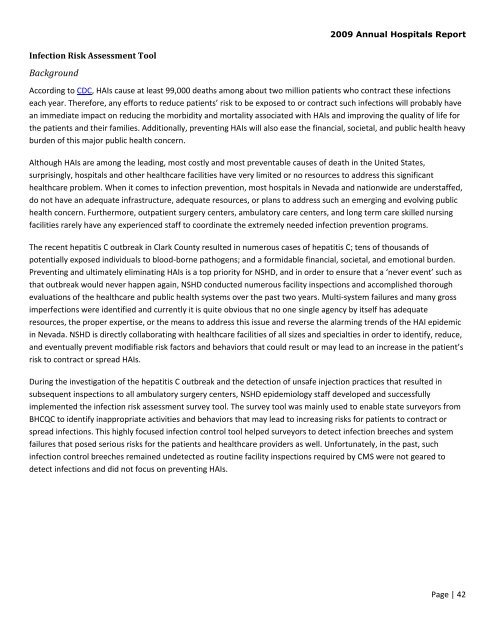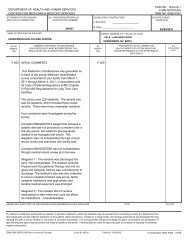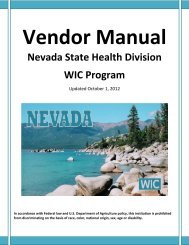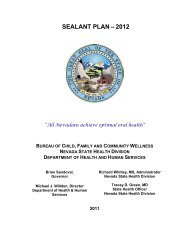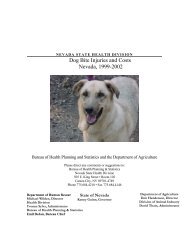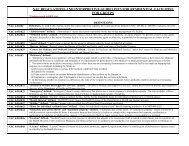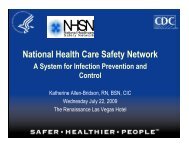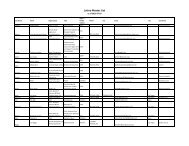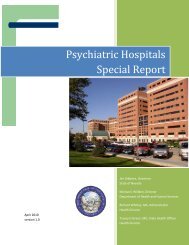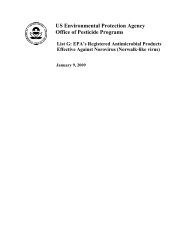2009 Annual Hospitals Report - Nevada State Health Division ...
2009 Annual Hospitals Report - Nevada State Health Division ...
2009 Annual Hospitals Report - Nevada State Health Division ...
Create successful ePaper yourself
Turn your PDF publications into a flip-book with our unique Google optimized e-Paper software.
Infection Risk Assessment Tool<br />
Background<br />
<strong>2009</strong> <strong>Annual</strong> <strong>Hospitals</strong> <strong>Report</strong><br />
According to CDC, HAIs cause at least 99,000 deaths among about two million patients who contract these infections<br />
each year. Therefore, any efforts to reduce patients’ risk to be exposed to or contract such infections will probably have<br />
an immediate impact on reducing the morbidity and mortality associated with HAIs and improving the quality of life for<br />
the patients and their families. Additionally, preventing HAIs will also ease the financial, societal, and public health heavy<br />
burden of this major public health concern.<br />
Although HAIs are among the leading, most costly and most preventable causes of death in the United <strong>State</strong>s,<br />
surprisingly, hospitals and other healthcare facilities have very limited or no resources to address this significant<br />
healthcare problem. When it comes to infection prevention, most hospitals in <strong>Nevada</strong> and nationwide are understaffed,<br />
do not have an adequate infrastructure, adequate resources, or plans to address such an emerging and evolving public<br />
health concern. Furthermore, outpatient surgery centers, ambulatory care centers, and long term care skilled nursing<br />
facilities rarely have any experienced staff to coordinate the extremely needed infection prevention programs.<br />
The recent hepatitis C outbreak in Clark County resulted in numerous cases of hepatitis C; tens of thousands of<br />
potentially exposed individuals to blood-borne pathogens; and a formidable financial, societal, and emotional burden.<br />
Preventing and ultimately eliminating HAIs is a top priority for NSHD, and in order to ensure that a ‘never event’ such as<br />
that outbreak would never happen again, NSHD conducted numerous facility inspections and accomplished thorough<br />
evaluations of the healthcare and public health systems over the past two years. Multi-system failures and many gross<br />
imperfections were identified and currently it is quite obvious that no one single agency by itself has adequate<br />
resources, the proper expertise, or the means to address this issue and reverse the alarming trends of the HAI epidemic<br />
in <strong>Nevada</strong>. NSHD is directly collaborating with healthcare facilities of all sizes and specialties in order to identify, reduce,<br />
and eventually prevent modifiable risk factors and behaviors that could result or may lead to an increase in the patient’s<br />
risk to contract or spread HAIs.<br />
During the investigation of the hepatitis C outbreak and the detection of unsafe injection practices that resulted in<br />
subsequent inspections to all ambulatory surgery centers, NSHD epidemiology staff developed and successfully<br />
implemented the infection risk assessment survey tool. The survey tool was mainly used to enable state surveyors from<br />
BHCQC to identify inappropriate activities and behaviors that may lead to increasing risks for patients to contract or<br />
spread infections. This highly focused infection control tool helped surveyors to detect infection breeches and system<br />
failures that posed serious risks for the patients and healthcare providers as well. Unfortunately, in the past, such<br />
infection control breeches remained undetected as routine facility inspections required by CMS were not geared to<br />
detect infections and did not focus on preventing HAIs.<br />
Page | 42


